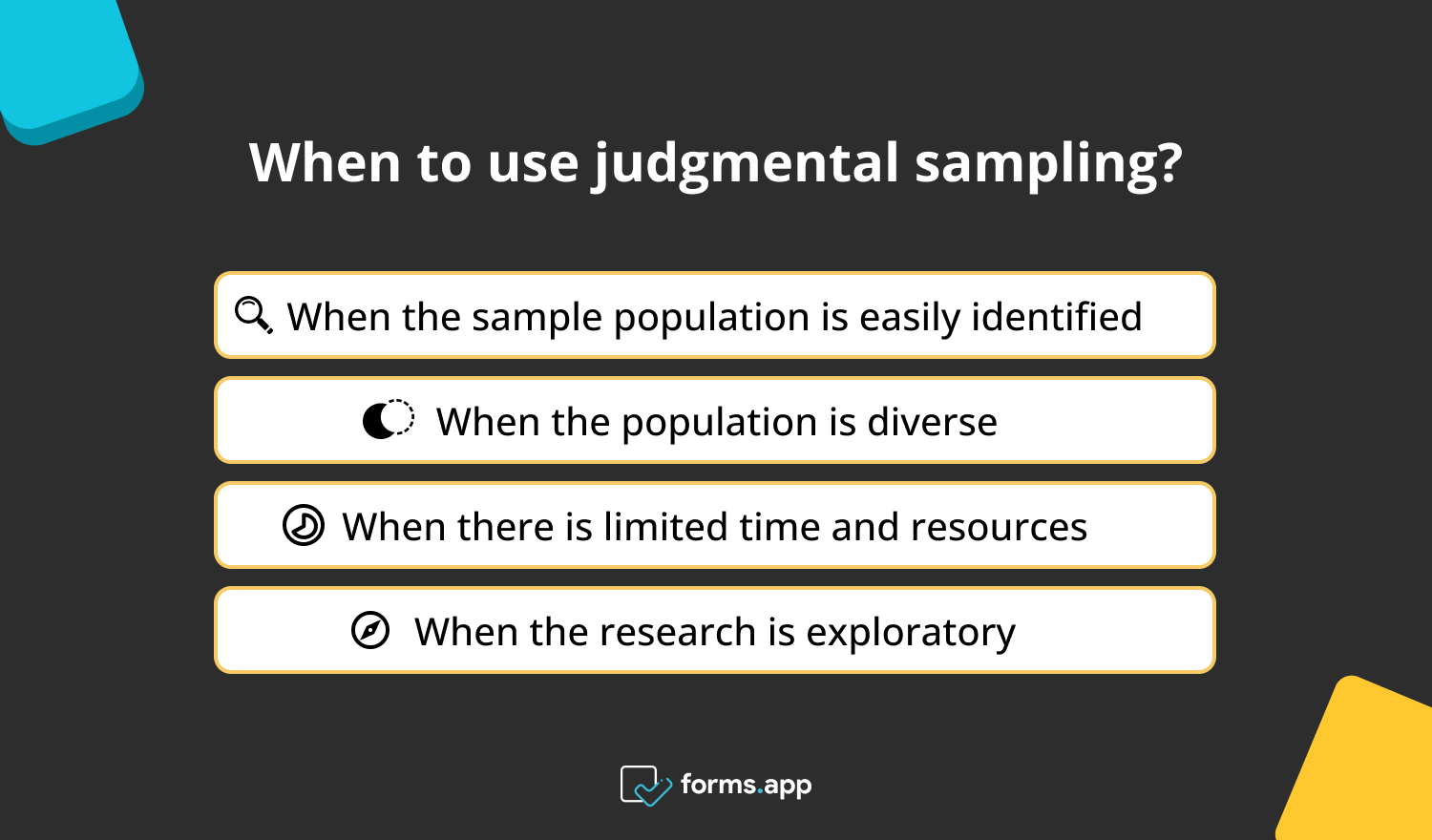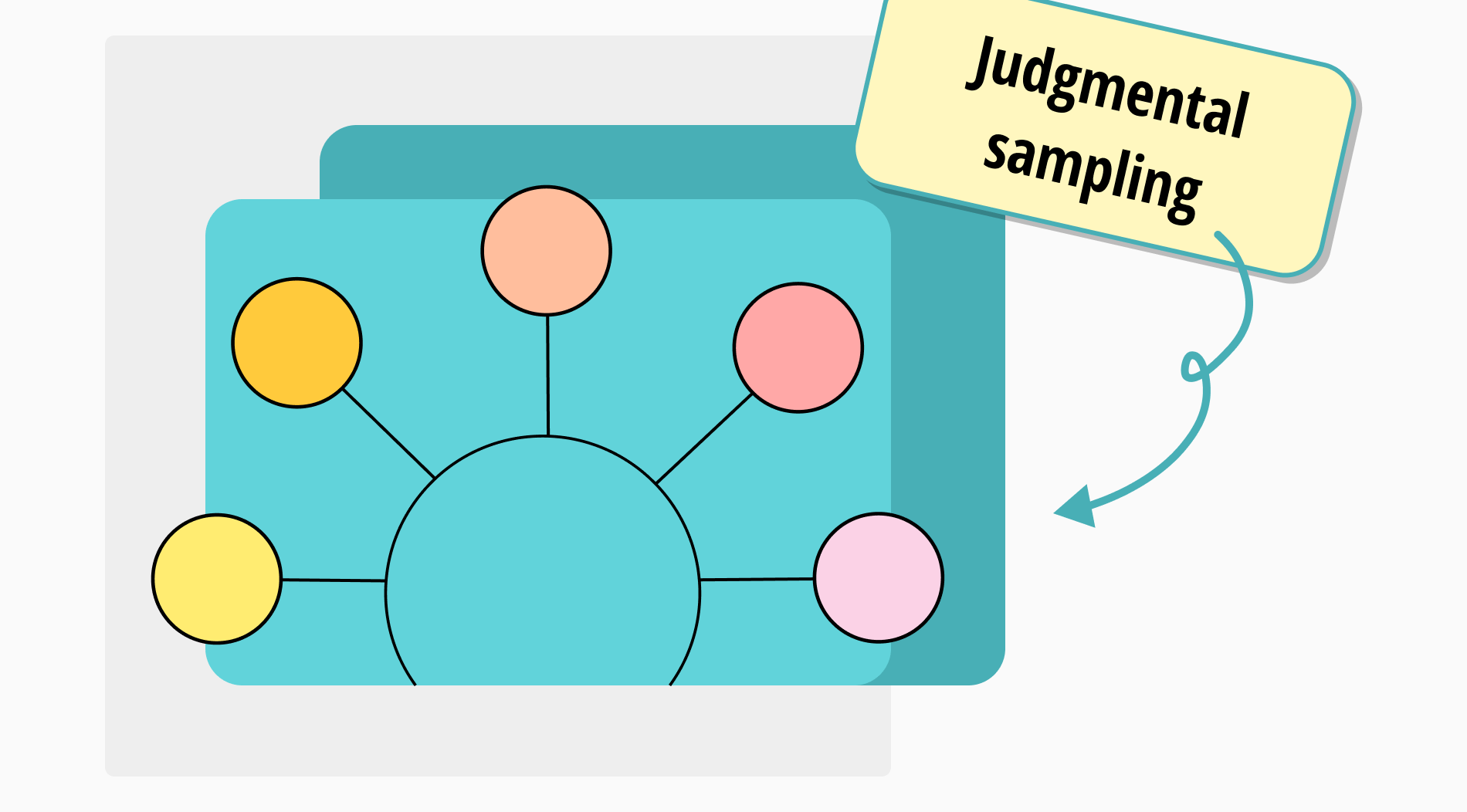Non-probability sampling is a sampling strategy where the researcher chooses samples based on their assessment instead of by chance. Judgmental sampling, also called authoritative sampling, is a non-probability sampling technique.
When just a small number of people exhibit the characteristic that a researcher is interested in, judgment sampling is the most beneficial. This article will explain the definition of the judgmental sampling method, judgment sample examples, and when to use judgmental sampling.
What is judgmental sampling?
Judgemental sampling is a non-probability sampling method that selects the sample based on the researcher's best judgment. The researcher must decide which components of the population should be represented in the sample.
The process of selecting a sample using judgmental sampling involves selecting items based on specific criteria, such as gender, educational level, age, socioeconomic status, or any other factor relevant to research by experts.
The judgment sampling approach is not scientific since the sample items are chosen based on the investigator's judgment, which means that the investigator's bias or personal prejudice might influence the findings.
When to use judgmental sampling?
When using judgment sampling, the researcher's previous ideas about the studied factors will impact the conclusions reached. When massive population sampling is impractical, and the researcher has subject-matter knowledge, judgment sampling is a good option. Here is when you can use the judgmental sampling technique:
- When the sample population is easily identified: Judgmental sampling is typically utilized when the sample population can be quickly and easily identified, and a small amount of data is needed.
- When the population is diverse: When the population is varied, and the researcher or sampling manager has knowledge or experience with the people, judgmental sampling may be employed.
- When there is limited time and resources: Judgmental sampling can be utilized when there is not enough time or money to execute a particular sample technique.
- When the research is exploratory: Judgmental sampling can also be helpful when conducting experimental research and attempting to get a preliminary understanding of a topic.

When to use judgmental sampling
Judgmental sampling examples
Judgment sampling is the only practical method for gathering data from a relatively small sample of people. Due to the decreased subject volume while utilizing judgment sampling, researchers can perform focus groups in addition to interviews and other more in-depth data-gathering procedures. Here are examples of judgmental sampling:
- A judgement sample example is when a researcher wants to examine the motorcycle models the person buys by the age ratio of motorcycle owners. The researcher can use judgmental sampling to select a sample of motorcycle owners or individuals they believe are most likely to purchase the motorcycle.
- When a researcher wishes to look at a group of people's views but cannot access a random sample, this is another instance of judgemental sampling in action. In this scenario, the researcher can choose a sample of individuals he feels is typical of the group he is researching using judgemental sampling.
- It can also benefit from judgmental sampling in quantitative research. For instance, a researcher may use judgemental sampling to choose a sample of individuals they think could offer the most illuminating data on a specific issue.
Frequently asked questions about judgmental sampling
Sampling is a crucial component of research since it helps to guarantee that investigations are carried out on an accurately representative sample of the population being studied. Judgmental sampling involves the researcher choosing participants based on their credentials or other criteria pertinent to the study. Here are frequently asked questions about judgemental sampling:
Convenience sampling and judgmental sampling are two distinct non-probability sampling methods used in research. Here is the difference between convenience and judgmental sampling:
Convenience sampling involves the researcher choosing participants based on their accessibility and availability. This approach entails selecting research participants who are easily reachable or readily available.
Judgmental sampling entails the researcher choosing the individuals most pertinent to their study goals. Both approaches have benefits and drawbacks, and the choice of sampling strategy relies on the purposes and resources of the study.
When choosing participants, judgmental sampling focuses on the researcher's judgment, whereas convenience sampling is based on accessibility and availability.
In judgemental sampling, the researcher chooses people or instances they feel best to reflect the population. They do this using their own experience or judgment. This approach is subjective based on the researcher's prejudices and beliefs. A haphazard sampling includes choosing conveniently located people.
A haphazard sampling includes picking individuals based on accessibility and convenience, whereas judgemental sampling depends on the researcher's skill and judgment in choosing participants.
While random selection does not ensure a representative sample and is more subject to bias, judgmental sampling seeks to produce a representative sample based on predetermined criteria.
In judgemental sampling, the researcher chooses individuals or cases for the sample based on their judgment or discretion and their knowledge and experience of the population being researched.
Statistical sampling approaches use random sampling methods to choose people or cases for the sample. As a result, there is an equal probability for every person in the population to be selected for the sample.
While statistical sampling is more objective and seeks to create a representative sample using random sampling procedures, judgmental sampling depends on the researcher's judgment and knowledge, which may add subjective bias.
The process of selecting participants for a study based on specific traits or criteria that align with its goals is known as purposive sampling. In contrast, the researcher's subjective judgment is used when selecting participants in a judgmental sampling method.
Non-random sampling strategies used in qualitative research include judgmental or purposive sampling. Judgmental sampling depends on the researcher's subjective judgment to choose individuals thought to be informed or reflect a specific demographic. In contrast, purposive sampling includes deliberately selecting participants based on precise criteria linked with the study.
Judgemental sampling entails the researcher choosing subjects or instances typical of the population of interest. The advantage and disadvantages of judgmental sampling are as follows:
Advantages of judgment sampling
- Time-saving: Judgmental sampling enables researchers to swiftly choose participants based on their comprehension of the research subject. Compared to other sampling techniques needing substantial data collection and processing, this can save time and money.
- Cost-effective: Compared to other sampling techniques, judgmental sampling needs fewer resources and less data gathering; hence it may be more cost-effective for researchers on a limited budget.
- More relevant to the research objectives: Judgmental sampling enables the choice of participants most pertinent to the study goals since it depends on the researcher's competence.
- Flexibility: Researchers might choose participants based on particular traits or standards that are significant to their study objectives.
Disadvantages of judgment sampling:
- Limited variety: Judgmental sampling may reduce the sample's diversity and variance, reducing the findings' dependability.
- Insufficient transparency: Judgmental sampling's participant selection procedure needs to be more open than other random or systematic sampling techniques.
- Sampling bias: A non-representative sample may come from the subjective opinion of the researchers, which may add unfounded assumptions or personal preferences. This may impact the generalizability and validity of the research findings.
- Findings are challenging to generalize: The generalizability of the results from a judgmental sample to the general population may be constrained due to bias and lack of representativeness.
Although judgmental sampling provides certain benefits, it has drawbacks, like sampling bias and a limited generalization capacity. As a result, researchers should carefully consider whether it is appropriate for their study when they decide to use this sampling technique.
Final Words
In summary, judgmental sampling is a non-probability sampling strategy in which the researcher purposefully chooses participants based on their judgment or knowledge of the relevant topic. The researcher uses judgemental sampling to pick persons with relevant expertise, experience, or traits to offer valuable data for the research project.
Typically, the sample is chosen based on the researcher's opinion or subjective criteria, which may add bias to the sample selection process. This article has explained the definition of judgmental sampling, when to use it, and advantages and disadvantages of judgmental sampling with all details.
forms.app, your free form builder
- Unlimited views
- Unlimited questions
- Unlimited notifications




